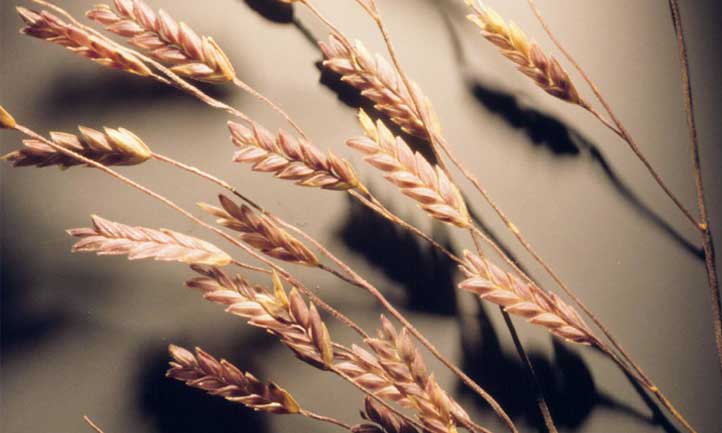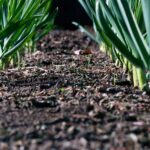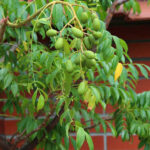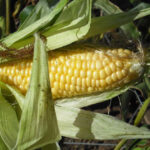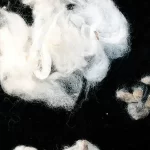Eragrostis spectabilis var. sparsihirsuta is an important member of efforts related to habitat remediation and water conservation. Preservation of natural ecology and our natural resources are important to gardeners these days. Perennial grass is a great option for accomplishing these efforts in our own gardens.
Another interesting reason to plant a native “short” grass like Eragrostis spectabilis is for erosion control. Planted prairie and plains grasses reduce flooding as their deep roots hold water and release it slowly – water that may otherwise carve the landscape and leach into the flood plain.
Not only is Eragrostis spectabilis (known commonly as love grass) a practical addition to a garden prone to floods, or a xeriscaped garden, its flowers look like reddish-purple clouds when they bloom in summer. They’re beautiful in dried flower arrangements too.
So let’s discuss this interesting grass so you can incorporate it into your landscape. If you do, you’ll have lovely grass that supports pollinators too.
Quick Care
 Close up of the seed heads of this gorgeous purple grass. Source: Matt Lavin
Close up of the seed heads of this gorgeous purple grass. Source: Matt Lavin| Common Name(s): | Purple love grass, tumble grass, petticoat climber, purple plains lovegrass |
| Scientific Name | Eragrostis spectabilis or Eragrostis spectabilis var. sparsihirsuta |
| Family: | Poaceae |
| Height & Spread: | 2 feet tall and 2 to 3 feet wide |
| Light | Full sun |
| Soil | Infertile, dry, sandy, or gravelly well-draining soil |
| Water: | Moist to dry soil; needs regular irrigation upon establishment |
| Pests & Diseases: | Aphids, spittlebugs, leaf spot |
All About Eragrostis spectabilis
Eragrostis spectabilis var. sparsihirsuta is a grass known commonly as purple love grass, tumblegrass, petticoat climber, and purple plains lovegrass. It is native to 41 states in America and is naturalized in many areas of North America, including California, Montana, and even parts of Mexico.
While this perennial grass isn’t short to most homeowners – at least compared to Bermuda or St. Augustine – it is considered a short grass in botanical terms. Growing up to 2 feet tall, you’ll find Eragrostis spectabilis growing in stands along disturbed sandy areas, limestone glades, upland savannas, sandy savannas, hill prairies, and sand prairies.
Purple lovegrass is a great plant for perennial borders and screens, as well as a liner for sandy paths year-round. Both live and dead foliage is striking and attract various beneficial insects and wildlife. It’s a host for the lovely Zabulon skipper butterfly larvae and provides nesting materials and food for ground-dwelling birds.
This warm-season member of the grass family (Poaceae) has long, slender leaf blades and a softly mounding habit. In early spring, new growth blades are light greenish-blue. As the year wanes into autumn, they turn reddish and, finally, take on the characteristic light gold that winter brings.
Eragrostis spectabilis is sometimes called purple haze due to the flowers that bloom in individual spikelets in the summer. As the flowers bloom and fade, the seed of this species will spread and overwinter. As the seed matures, it germinates, and grass emerges again the following spring. The bloom time for this grass lasts from late summer to mid-fall.
Because the grass is clump-forming, it often spreads slowly after it’s been established in its native habitat. The same goes for garden plantings. This grass with purple flowers is great for meadows full of native plants and meant to support wildlife. It can also be a stunning sight in gravelly areas of your garden or anywhere you have well-drained soil.
Do not mistake this grass for Eragrostis spectabilis var. Sparsihirsuta (Lehmann lovegrass) or Eragrostis curvula (weeping lovegrass). Both species are invasive. Thankfully they do not possess the lovely purple flowers so characteristic of this Eragrostis species.
This grass was called petticoat climber because it would often get caught on women’s petticoats in the middle ages. Another of its common names, tumblegrass, refers to its ability to detach and roll around the area surrounding the planting site, much like a tumbleweed.
Purple Love Grass Care
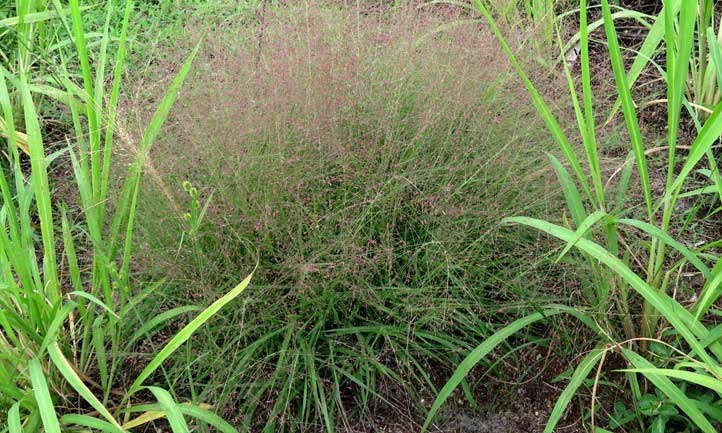 Purple lovegrass in the wild. Source: Treegrow
Purple lovegrass in the wild. Source: TreegrowNow that we’ve made some distinctions about how purple lovegrass grows and which of its relatives are invasive, let’s talk about how to care for it. You’ll find it doesn’t need much care, as it loves sandy or gravelly growing media.
Full Sun and Warm Temperatures
Like most members of the grass family, mostly full sun is necessary. Plant purple lovegrass in an area that gets 6 to 8 hours of full sun. Some afternoon shade is alright. Warm areas are best for this native grass, but freezing weather isn’t an issue.
Purple lovegrass can handle the intense Texas heat in late summer up to 120° Fahrenheit. It also handles lows in the single digits in winter. Its grass blades will die back then, but that’s no problem. The roots will be well-protected under the soil line, and the grass can remain as a wildlife habitat for ground-dwelling and foraging birds. Lovegrass has a wide hardiness zone range in North America, from zone 5 through 9. It does well outside this hardiness zone range too, but may be annual.
Water and Humidity
If you plant a stand of lovegrass, water it slowly and deeply a couple of times a week to help its roots establish themselves in the ground. After that, there’s no need for regular watering. Eragrostis spectabilis enjoys dry locations, like limestone glades and gravelly roadsides. Soil moisture isn’t a problem, either.
People often plant native grasses on flood plains to assist with erosion control. The short rhizomes of these native plants hold water under the ground with no issue. Similarly, humidity isn’t a problem. Those who have a garden in the salty humidity of the coast find these plants thrive there. While transplants and newly seeded plants will need some protection, established bunches of lovegrass can handle quite a beating.
Soil
We have touched on this throughout this piece, but the Eragrostis spectabilis species has a wide tolerance for soil types. Sandy or gravelly soil is perfect for purple lovegrass. Sandy soil is great because well-drained soils are a must for this plant. But rich soil or clay soil that is well-drained is also an effective growing medium. If you must, amend the soil with agricultural sand (like glauconite greensand) or native sand to provide some drainage.
Fertilizing Eragrostis spectabilis
Eragrostis spectabilis needs no fertilizer. In the wild, you’ll find it growing in sandy or gravelly soil, in upland savannas, and in the sandy soils of salty coasts. Purple plains lovegrass is a plant that thrives in conditions where disturbed and well-drained soil is readily available. Native plants in the grass family are very tough and save competition from invasives. They don’t have any problems thriving in rich meadows and poor soil conditions alike.
However, feeding this plant species with a high nitrogen fertilizer upon establishment will assist with new growth. To avoid burning the roots of the plant, dilute a full spectrum liquid fertilizer and feed the base of the plant in your garden. Fertilizing this way assists the plants in developing mostly basal leaves, but this feeds directly into flower development later in the summer season.
Pruning Purple Love Grass
While cutting these plants isn’t necessary, you can prune them to the ground in the garden in early fall through winter. This can assist plants in perennial borders by helping them maintain their softly mounding habit. Carry out this pruning process by hedge trimming or mowing the grass. Whatever you do, please do not cut them back in spring as they begin to grow new green leaves.
Though these native plants spread slowly in a garden, you can prune them during their bloom time to prevent too much spreading. Deadhead the lovely reddish purple clouds that bloom in late summer and add the airy cloud-like blooms to arrangements as cut flowers. Or simply cut the individual spikelets and dispose of them.
Propagating Before Early Spring
Because this plant spreads slowly, it may appreciate support in your garden. There are two ways to propagate these plants: by seed and by division. Simply let the grass flower and the seeds mature in your garden. They’ll drop seed to the ground and produce new foliage growth in early spring. You can also collect the heads and spread them yourself.
Carefully separate the seed from each sheath, and discard the refuse. Alternatively, keep the seed sheath to remain among the separated seeds as a sedimentary material to prevent them from blowing away after broadcasting them. Then direct sow them in the garden, and spread them on the exposed earth in early fall. They require light and cold stratification for germination.
Provide either some sand, vermiculite, or some form of sediment to keep them from blowing away in the wind. Water lightly for a couple of weeks, and as the warm season of spring approaches, you’ll have new plants. Divide the plants to grow elsewhere in the garden every winter while the plant is dormant. Dig around the base of the plant about 6 inches from the base of the foliage.
Then unearth the entire grass clump with the root ball intact, and locate the rhizomes. Separate these and put the plugs in other parts of the garden with full sun and well-draining soil. Anywhere you want plumes of this plant’s reddish purple flower is appropriate. Water your transplants deeply and slowly for a couple of weeks while they get established. In spring, you should see mostly basal foliage growing.
Troubleshooting Purple Love Grass
This drought-tolerant, deer-resistant species isn’t prone to disease or pest issues in gardens. But there are a couple of things that can arise. Let’s discuss those now.
Eragrostis spectabilis Growing Problems
Most of the growth problems related to this plant occur when it’s planted in improper growing conditions. If you plant it in an area that doesn’t get enough full sun, you’ll notice there may not be much foliage or as many flower heads present in late summer. Also, remember to provide soil moisture for new transplants and seeds to ensure they make it to the warm season flower period.
Pests
Aphids aren’t a huge issue for gardens of lovegrass, but look out for infestations of them. They may take away energy from the plant as they suck sap from the foliage. Because this plant is host to important wildlife and pollinator species, I can’t recommend the use of even organic pesticides. Instead, use applications of a strong stream of water from a hose to rip their mouth parts and prevent further feeding.
Spittlebugs are either green or black leafhopper-like insects that suck plant sap from the stems of lovegrass. Their feeding may result in premature browning of leaves in late summer. Most of the time, plants survive despite spittlebug feeding. To control them, spray them with water, and remove their spit-like egg masses from the stems of your lovegrass.
Yes, lovegrass is deer-resistant, but it’s not bird-resistant. I can’t tell you how many times I’ve seeded native forbs and grasses in my yard, only to have birds eat the seeds before it has a chance to germinate. To keep your seed safe, provide a decoy feeder that’s always stocked, or cover your seeds with netting or garden straw (like the Healthi Straw we stock in our online store).
Diseases of Eragrostis spectabilis
Leaf spot is a rare disease you may have to deal with when it comes to drought-tolerant lovegrass. Remove damaged leaves as they crop up, and keep airflow between plants by dividing the clumps regularly. Remove any discarded cut flowers from the base of the plant as well as other garden debris. Plant your lovegrass among resistant plants to prevent this disease.
Frequently Asked Questions
Q: Is Eragrostis spectabilis invasive?
A: No. It has relatives that can be invasive in certain areas, though.
Q: What can I plant with purple love grass?
A: Plant it with other native grasses and forbs to create a pocket of drought-tolerant species in your garden. Or plant it with taller grasses for a stunning multi-dimensional view.
Q: Is purple love grass a perennial?
A: In most areas, yes. It may be a tender perennial or annual in areas with very cold winters, though.
Q: How do you grow Eragrostis spectabilis?
A: Check out this piece to learn more!
Q: What is love grass good for?
A: So much. It supports native wildlife and provides a low-lying screen or border in a garden.
Q: How do you maintain love grass?
A: Prune it back and divide it annually to keep it healthy, and monitor the plant for pests and diseases. You can also use the seed heads for cut flower arrangements.
Q: Why is it called love grass?
A: This 2-foot-tall grass was known in the middle ages to catch on the petticoats and dresses of women. Thus, love grass.
Q: Can you mow love grass?
A: Absolutely. Lovegrass can take heavy foot traffic and regular mowing.

